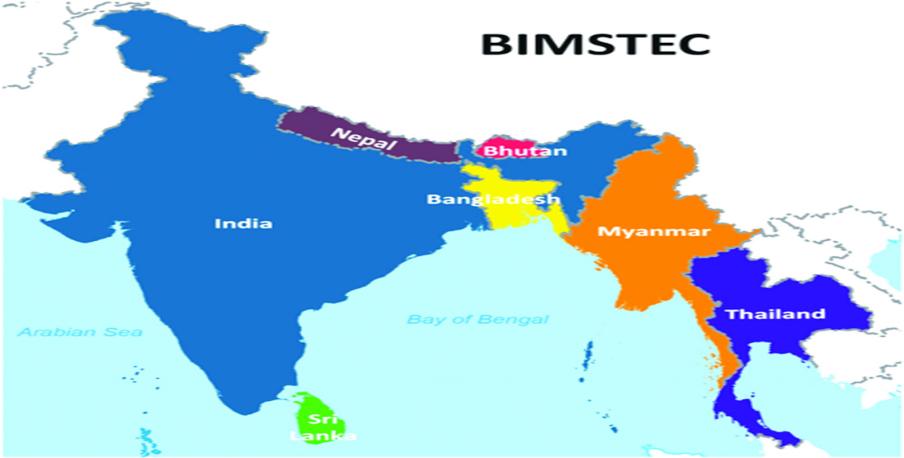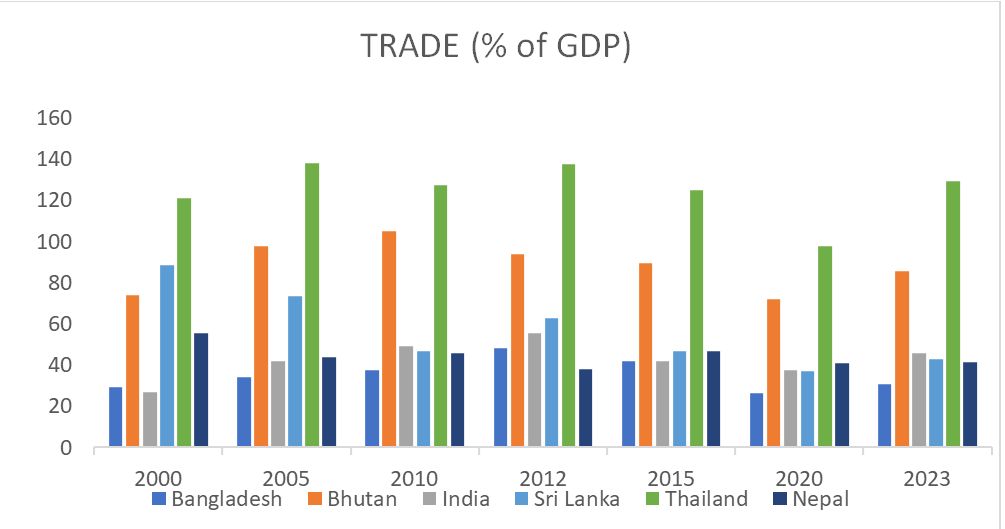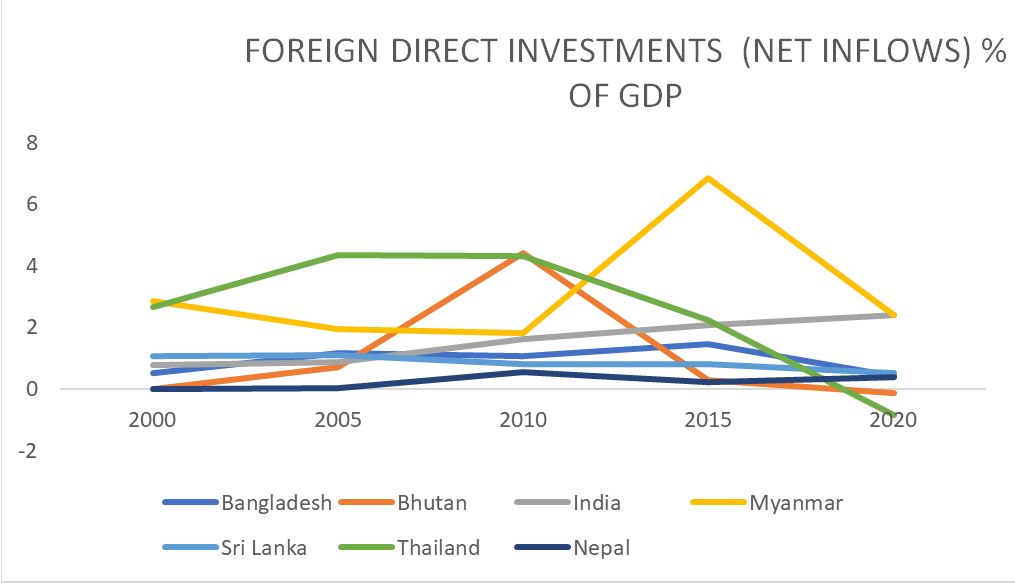India’s economic trajectory and implications for BIMSTEC
India’s economic trajectory and implications for BIMSTEC
Indian economy with its strong democracy and solid alliances, is predicted to develop at the quickest rate of growth in the world and rank among the top three global economic powers within the next ten to fifteen years. One of the main factors influencing the Gross Domestic Product (GDP) in the second half of FY25 is the government's ongoing emphasis on capital expenditures, combined with strong domestic demand for investment and consumption. India’s growth trajectory provides opportunities for interregional trade with its regional groupings, especially for Bay of Bengal Initiative for Multi-Sectoral Technical and Economic Cooperation (BIMSTEC), the grouping of 7 nations - Bangladesh, Bhutan, India, Myanmar, Nepal, Sri Lanka and Thailand. By utilizing the geographic and cultural connections of the Bay of Bengal region, BIMSTEC was founded in 1997 with the goal of fostering economic cooperation, trade, and cultural exchange among its members. It’s known for its geopolitical significance, economic collaboration, and strategic partnership. This collaboration goals are to decrease the development gap between the member nations, gradually liberalize and advance the important areas through greater cooperation between the parties, and increase and improve economic, trade, and investment relations. This regional organization also focuses specifically on the transportation and energy sectors. Access to the Indian market and Indian investments in services and infrastructure are advantageous to BIMSTEC nations.
Given the "Neighbourhood First" policy, the Act East policy, and the need to connect South and Southeast Asian countries, BIMSTEC has been crucial for India. The role is evident in the context of heightened regional collaboration in critical areas of disaster relief, trade, agriculture, poverty alleviation, culture, tourism, networking, and security and counterterrorism. This has been the region's action strategy. For international investors considering the larger Bay of Bengal region, India may act as a link. Infrastructure projects with India-Thailand- Myanmar trilateral highway, cross border electricity trade, security and stability are some key areas. India has been given the chance to reestablish its previous relationships with its former allies, with whom it had close ties and links. With a combined GDP of 2.7 trillion, South East Asia is home to about more than 1.6 billion people, or roughly 22% of the world's population, with combined GDP in trillions, BIMSTEC plays a vital role also promotes socioeconomic ties between South and Southeast Asia.

Importance of Intra regional Trade and Investments for BIMSTEC Region
Trade is developing as a growth engine in this area, which has the potential to support regional development and prosperity. Its member countries’ interregional trade can be improved with strong global value chains integration, technological advancements, and long-term plans. Bangladesh and Thailand are important trading partners of India. India is the largest exporter and importer in the BIMSTEC region with Thailand as the second largest exporter. Nepal and Bhutan having smaller shares in exports and imports. However, recently Bangladesh's garment industry, which is strongly dependent on Indian yarn imports, has been particularly affected by the havoc of supply chains caused by the suspension of yarn imports and the temporary shutdown of land ports. Bangladesh's exports to third nations have been impacted by the higher logistics costs and delays brought on by India's cancellation of the transshipment terminal. Landlocked nations like Nepal and Bhutan that depend on Indian ports to reach international markets are especially affected by the trade dispute.
The value of India-Thailand bilateral trade was $15 billion in 2023. Automobiles, machinery, food items, and other items were among the goods that India exported. Bangladesh has also been a solid partner with composition of traded goods like textile & refinery. Tea, spices, and rubber are among the trade goods that India exports, valued at USD 13 billion, while Sri Lanka and Nepal are worth about USD 7 billion.
India's bilateral investments with the countries of the BIMSTEC in manufacturing, services, energy, and infrastructure are being made to improve regional connectivity and bilateral economic ties with concentrated industries including logistics, textiles, and power generation. Examples include the Arun 3 hydroelectric project with Bhutan, the Oil Tank Farm with Sri Lanka, the Agricultural Investments for Thailand, and the Multimodal Transport Project with Myanmar.
Figure 1 given below shows trade as a percentage of GDP for BIMSTEC countries, Thailand has the highest proportion of its trade as a percentage of its GDP, followed by Bhutan.
Figure 2 represents the net Foreign Direct Investment inflows as a percentage of GDP for BIMSTEC region.
Figure 1 Source : World Bank, Myanmar’s statistics was not available on world bank data website
Source : World Bank, Myanmar’s statistics was not available on world bank data website
Figure 2  Source: World Bank
Source: World Bank
Potential Region
With a population of over 1.6 billion people and a combined GDP of almost $4.7 trillion, the BIMSTEC area offers significant market opportunity. The low intraregional trade rate of roughly 7%, however, suggests that there are a lot of growth prospects, especially in the agricultural sector and trade facilitation programs (BIMSTEC official website)
Due to its wealth of natural resources, including coal, gas, and hydropower, the BIMSTEC region has enormous potential for both clean energy development and capital accumulation. Cooperation in regional energy cooperation and investments in renewable energy can improve sustainability and economic integration among member states. Synergies can be drawn and there can be prospective areas of partnership under the following domains.
SERVICIFICATION
The industries of IT, business and professional services, financial services, tourism, and transportation would all be included in the trade and interaction of services. Among other things, mutual recognition agreements and digital access would serve as the foundation for the mechanisms for such service cooperation.
ENERGY SUPPORT
There is a lot of untapped energy potential in the area, especially in the form of eco-friendly hydropower found in Himalayan nations like India, Bhutan, and Nepal. All of the member nations have access to biomass, and natural gas is dispersed throughout the region.
DIGITALISATION
E-Commerce regulatory environment, improving digital literacy, digital benefits for societal advantage, investing in 5 G tech with business-friendly regulatory framework.
INTERWINED LANDSCAPE
BIMSTEC offers special development prospects. For centuries, the Bay of Bengal has been a major centre for trade, commerce, and culture among its member states. For the majority of BIMSTEC nations, it also serves as their entryway to the Indian Ocean.

Challenges
India should look to identify potential product groups that can be pushed into the export market, identify major markets that can absorb a nation's potential products, choose the best manufacturing export units that can take on the responsibility of entering the overseas markets, give exporters access to adequate and improved infrastructure, and raise tariff rates to the international level in order to increase exports to other BIMSTEC countries.
While making sure that its domestic economy complies with strict international product standards and best practices, India hopes to use its trade relations to increase export competitiveness. This strategy is necessary to improve the quality of Indian products and integrate into international markets.
BRICS bloc has a number of obstacles to overcome, including as the intricacies of de-dollarisation initiatives, economic volatility, and the difficulty in reaching an agreement among its various members. Furthermore, the group's ability to effectively pursue a common goal is constrained by its identity problem and reliance on a common discontent with Western supremacy.
It is important to combine artificial intelligence (AI), big data, and the Internet of Things (IoT), India hopes to foster financial cooperation and improve fintech and digital connection among its neighbours. The goal of this project is to increase connectivity in order to facilitate faster communication and more effective transportation of goods, which will open up new business prospects. The aim is to enable smooth e-commerce by addressing connectivity in the digital and cyber realms.
For BIMSTEC, investments in human resources and technology are essential, especially when it comes to meeting the infrastructure demands in nations like Nepal and Bhutan. Trade is hampered by high transaction costs and intricate customs procedures; therefore, trade facilitation and transportation connectivity reforms are necessary to improve regional cooperation and economic progress.
Future Recommendations
Phased completion of a regional free trade agreement would expedite implementation and encourage investment, employment creation, technological alliances, and services.
Fostering a more favourable business environment amongst members, which may entail reducing barriers to foreign direct investment in the majority of industries, enhancing business ease, automating and integrating all pertinent customs agencies into a single system, and improving governance in the areas of labour, IPR, innovation, and dispute resolution.
Enhancing BIMSTEC states' energy cooperation by working together to create a regional power grid, a special fund for funding and supporting renewable energy companies, and studies on green hydrogen for commercial and civil applications.
Developing disaster management monitoring centers and conducting a marine ecosystem survey throughout the region to safeguard sensitive species and the populace from the severe negative effects of climate change and to provide thorough weather monitoring.
Increasing regional cooperation on tourism among BIMSTEC countries, including creating common safety and security protocols among member states and hosting multilateral exchanges on tourism
Creating an agricultural innovation agreement that would share sophisticated tools for agriculture among BIMSTEC states based on natural advantages and agri-climatic zones. Improving infrastructure and expediting regulatory approvals to encourage increased regional mobility of pharmaceutical items and encouraging a regional approach combined with an all-encompassing framework of policies and services in order to achieve development objectives.
Way forward
In order to promote regional economic integration, improve connectivity, and increase India's geopolitical influence in the Bay of Bengal region, trade between India and BIMSTEC is strategically essential. The significance of this collaboration is highlighted by several important factors:
The removal of tariff and non-tariff trade barriers depends on the BIMSTEC Free Trade Agreement (FTA), which is presently being negotiated. Increased intraregional trade would make it simpler for local businesses to reach India's customer base, which is among the biggest and fastest-growing in the world. In exchange, new market prospects in nearby economies are another dimension.
IoT, fintech platforms, and international digital payment systems are some of the ways that India is leading the charge to encourage digital integration within BIMSTEC.
Regional expansion of programs like the Unified Payments Interface (UPI) might promote digital inclusion, streamline corporate operations, and enable smooth financial transactions. BIMSTEC has the potential to develop as a regional center for supply chains, especially in industries such as Textiles, Electronics, Pharmaceuticals, and Agro-processing.
With India serving as an anchor economy, the area has significant strategic potential to draw in foreign capital, diversify value chains and reduce dependency on China. Trade and economic cooperation with BIMSTEC offer India a multi-dimensional strategic advantage—enhancing market access, promoting connectivity, integrating supply chains, and fostering regional stability. Finalizing the FTA, strengthening digital and physical infrastructure, and deepening economic ties will help BIMSTEC emerge as India’s key regional economic bloc and a model for South-Southeast Asian integration.
Conclusion
India's growing trade and investment ties with the BIMSTEC area reflect not only economic expansion but also a common goal of regional integration, development, and resilience. With sustained efforts in connection settings, digital transformation, and regional cooperation frameworks like the Free Trade Agreement, BIMSTEC is set to become a key component of India's Indo-Pacific importance, having grown from a trade value of over 40 billion. As we navigate through economic transformations and global uncertainties under the new world order, the BIMSTEC model can serve as a paradigm for sustainable regional identity.
Sakshi Bhayana
Senior Assistant Professor,
Vivekananda Institute of Professional Studies, Technical Campus
REFERENCES
Sharma, A., & Rathore, C. K. (2015). BIMSTEC and BCIM Initiatives and their Importance for India. Cuts International, 1-20.
Kaul, M. M. (2006). Regional groupings: An overview of BIMSTEC and MGC. South Asian Survey, 13(2), 313-322.
Kaur, G., Sarin, V., & Dhami, J. K. (2016). Analysis of intraregional trade and investment among India and BIMSTEC: Prospects and challenges. International Journal of Social and Economic Research, 5(3), 60-67.
Mohan, N. C. (2016). BIMSTEC: an idea whose time has come. ORF, November, 9.
Banerjee, D. K., & Dey, D. (2016). India and BIMSTEC: A comparative study of the trade potential of India's energy sector products in BIMSTEC and BIMSTEC 1 region. Available at SSRN 2874294.
Chowdhury, A.B., & Neogi, D. (2013). An economic overview of BIMSTEC countries: (1997-2011). Journal of Asian Business Strategy, 3(8), 210-223.
Chowdhury, A.B., &Neogi, D. (2016) Identifying suitability of commodities for trade among Bay of Bengal initiative for multi-sectoral technical and economic cooperation (BIMSTEC) nations: An application of revealed comparative advantage approach. International Journal of Management Sciences and Business Research, 5(5), 15-27.
Mukherji, I.N., & Paswan, N.K. (2007). India's trade and investment opportunities in BIMSTEC. In T. Nirmala Devi (Ed.). India and Bay of Bengal Community: The BIMSTEC Experiment, 60-105.
Nag, B., & De, D. (2007). Asian integration process and BIMSTEC. Centre for Studies in International Re Relations and Development, Discussion Paper No. 35, 1-24.
BIMSTEC official website : https://bimstec.org/publications
https://indiaseatradenews.com/indias-increased-trade-trajectory-with-bimstec-countries/
https://www.cii.in/International_ResearchPDF/BIMSTEC_BUSINESS_SUMMIT_ReportWeb.pdf
https://bimstec.org/images/data_page_pdf_file/1700034345_MAJOR-SOCIO-ECONOMIC-INDICATORS-OF-BIMSTEC-MEMBER-STATES-for-website.pdf
Latest News Today: Latest News Headlines, Breaking News, Current News | Mint














